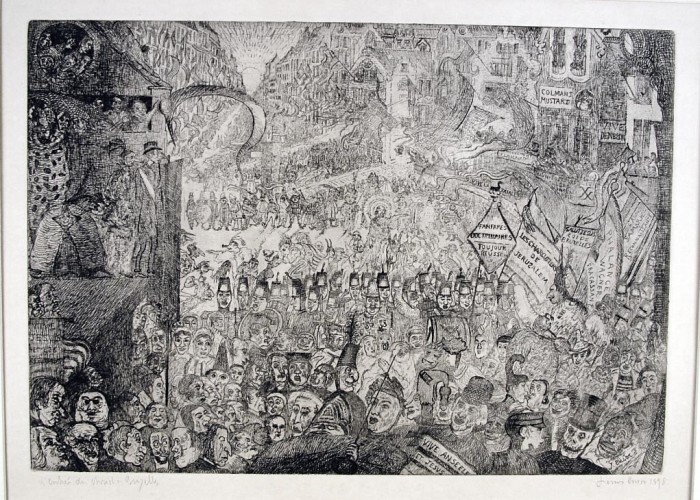The Entry of Christ into Brussels

James Ensor (1860-1946), The Entry of Christ into Brussels, etching and drypoint, 1898, on a cream colored simili Japan paper, signed, dated and titled recto, countersigned and titled verso, 9 ¾ x 14 ¾, the sheet 14 x 18 1/8 inches. Reference: Elesh 118, fourth state (of 4), Taevernier 114, third state (of 3). In superb condition, with some slight rubbing margins verso only, some tiny creases verso margins with archival matting.
A very fine dark impression, with wonderfully clear detailing, printing with relief.
Provenance: Paul van der Perre Behaegel, with their collector stamp (BG in a circle) verso (not in Lugt)
Sale: CG Boerner, to current owner.
The Entry of Christ into Brussels is perhaps Ensor’s most famous image, both through the painting and the print. In addition to the astonishing – and of course successful – complexity of the composition, the Entry shows in exquisite detail Ensor’s talent as a draftsman. Here is the myriad of faces, feelings and activities found throughout his work, but no where else so concentrated in a single composition.
Christ, a smallish figure, is located at the center of the composition, riding on a donkey. All around him are the citizens of the town – some stolid, some skeletal; wearing masks, demonstrating, playing music, marching, waving, kissing, snarling, watching – many staring at him, others at us. The scene is a carnival.
The related painting is in the J. Paul Getty Museum, Malibu; the Getty has a related drawing as well. The print is not identical to the painting at the Getty; the composition is reversed, and there are additional characters, other flags waving as part of the demonstration; the print may also have a darker quality, as exemplified by the many characters (not found in the painting) viewing the scene from the crevices and rooftop of the viewing stand at the left. Although the painting is perhaps Ensor’s greatest work, Ensor, the consummate artist, would never have been satisfied merely to copy it as a print; the print has a unique quality and flavor of its own, making it one of the masterpieces of printmaking.